Frank Six
The Frank Six (フランクシックス) is a series of Japanese 6×6 folding cameras produced from 1950 to 1954 by Tōsei Kōki. At the very beginning, the camera was also sold as the Beauty Six (ビューティシックス) by Taiyōdō Kōki. The Sanon Six (サノンシックス), Muse Six (ミューズシックス) and Liner Six are later rebadged Frank Six models.
Contents
The single-format Frank Six and Beauty Six (1950)
Description

|
| Beauty Six (1950) no.1611. Picture copyright David Young at www.furnfeather.ca. (Image rights) |
The single-format Frank Six and Beauty Six have nothing in common with the later Beauty Six released in 1953. They are horizontal folders, with three-part folding struts inspired by the Ikonta. There is a T.K logo on the folding struts, certainly for Tōsei Kōki — it would stay on all the later Frank Six models. The top and bottom plates are chrome finished. The shape and layout of the top plate are similar to the early models of the Olympus Chrome Six. There is a tubular optical finder in the middle, whose rear has a conical torpedo shape. The body release is on the right and the folding bed release is on the left, in front of the accessory shoe which is attached by a single large screw. The advance knob is at the left end; it is quite high and has a conical base. There is a decorative film flange on the right end. The name is engraved in the top plate, in front of the shutter release, either as Frank.six in lowercase letters or as Beauty six in cursive letters. The body serial number is engraved just below.
 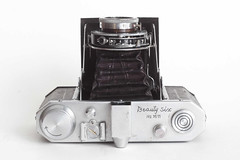 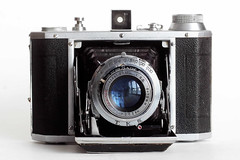
|
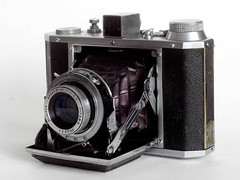 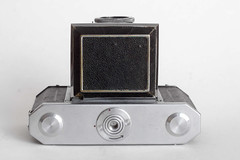 
|
    
|
| Beauty Six (1950) no.1611, Seriter Anastigmat 75mm f/3.5 lens no.2234, TKS shutter. Pictures copyright David Young at www.furnfeather.ca. (Image rights) |
 
|
| Back opening button, open and closed. Pictures copyright David Young at www.furnfeather.ca. (Image rights) |
The back is removed together with the bottom plate for film loading. It is locked in place by a rotating button in the middle of the bottom plate, with a red dot and an arrow indicating the opening direction. There are plain metal plates at both ends of the body, acting as a light seal for the removable back. The camera is single format, taking 6×6cm pictures only. The back has a single red window, protected by a horizontally sliding cover moving under an unusually long metal part, with a diamond-shaped frame for the window itself.
The lens standard has a plain round top and does not have the typical self-timer linkage of the Frank Six. The lens is a front-cell focusing 75mm f/3.5, the shutter gives B, 1–200 speeds, has a self-timer and is synchronized via a single pin at the top.[1]
Early documents on the Beauty Six
The earliest documents known so far are for the Beauty Six, advertised from July to November 1950 and featured in the October 1950 issue of Ars Camera.[2] The September advertisement in the same magazine shows a picture of the camera, and mentions a Seriter 75/3.5 lens, B, 1–200 speeds shutter speeds, a self-timer and flash synchronization.[3] The only company name given in the document is Taiyōdō Kōki.
Surviving examples
 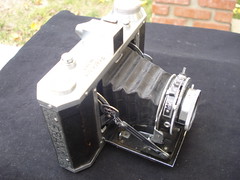 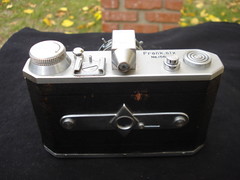
|
     
|
| Single-format Frank Six no.1563, S.O.W. Anastigmat 75mm f/3.5 lens no.2951, TKS shutter, SEMIX marking. Pictures by mr.hockeyman911. (Image rights) |

|
| Picture by mr.hockeyman911. (Image rights) |
The single-format Frank Six pictured above has body no.1563, and is the only such camera observed so far. Its folding bed release is close to the advance knob, further to the left than on any other camera of the family. It has etched metal plates on the side, with the name FRANK in relief capital letters. The shutter is identified by the name TKS in double struck style at the bottom of the rim. It is synchronized via a single pin at the top. Its black front face also has an unusual SEMIX marking at the top, certainly Tōsei's T.K logo on the right, and perhaps another marking at the bottom. The lens is an S.O.W. Anastigmat 75mm f/3.5.
The same FRANK markings in capital letters have been observed on another example, pictured at Robert Monaghan's 'medfmt.8k.com' website.[4] It has a silver front standard with no logo, and it is not known if it has one or two red windows.
 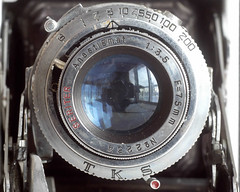 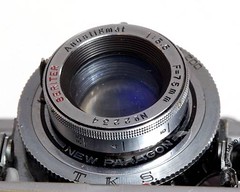
|
| Beauty Six no.1611: Seriter Anastigmat 75mm f/3.5 lens no.2234 and TKS shutter, FRANK and NEW PARAGON markings. Pictures copyright David Young at www.furnfeather.ca. (Image rights) |

|
| Beauty Six no.1611 with original box. Picture copyright David Young at www.furnfeather.ca. (Image rights) |
Two surviving examples of the 1950 Beauty Six have been observed so far, with body no.1611 and no.1736, later than those of the above Frank Six.[5] Their folding bed release is at the same position as on the later regular Frank Six. They both have a Seriter Anastigmat lens.
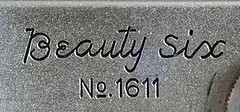
|
| Picture copyright David Young at www.furnfeather.ca. (Image rights) |
The camera no.1611 pictured in this page comes with its original case, in red and blue colours, inscribed Beauty SIX and T.K.K. The latter initials were used by Taiyōdō Kōki on later Beauty models, and certainly don't correspond to Tōsei Kōki. The same example has a TKS shutter, inscribed T.K.S. in double struck style at the base of the speed rim, certainly made by Tōsei Kōki. Its shutter plate is black with one metal stripe on each side, and has FRANK at the top and NEW PARAGON at the bottom. The brand name Frank was probably the property of Tōsei Kōki, and would later become the name of the camera itself. The words NEW PARAGON are also found on some examples of the postwar Gelto; their meaning is unknown.
The regular Frank Six
The regular Frank Six models are called Frank Six Model 1951, Frank Six Model 1952 and Frank Six Model I, according to the markings on the camera itself.
Description
The regular Frank Six are dual format cameras, and can take 6×6cm or 4.5×6cm format pictures when using an internal mask. The back contains two red windows, one for each format, protected by a cover horizontally sliding under a black plate. These black plates are engraved 4.5 X 6 and 6 X 6 to indicate the picture format. Two red lines in the viewfinder delineate the field of view for 4.5×6cm pictures.
The lens standard has protruding corners, one of them having a round lever actuating the self-timer.[6] The rear of the tubular finder and the shutter release differ from that of the Beauty Six. The accessory shoe is attached by three small screws. Red O and L indications (for Open and Lock) were added to the back opening button at some time.
The name Frank six is engraved in the top plate in cursive letters. The model name MODEL 1951, MODEL 1952 or MODEL–I– is engraved just below, in capital letters. The analysis of the serial numbers of the Seriter lens indicates that the Model 1951 and Model 1952 predate the Model I.[7]
All the regular Frank Six have a TKS shutter, with B, 1–200 speeds, a self-timer and a synch pin at the bottom right; the name TKS is engraved at the bottom of the speed rim. All the cameras have a front-cell focusing lens: a few examples of the Model 1951 have a Nomular 75mm f/3.2,[8] whereas the other have a Seriter. It is engraved C SERITER Anastigmat on the early examples and SERITER Anastigmat on the late ones (SERITER is written in red in all cases). Nearly all of them are 75mm f/3.5 but some might have 80mm focal length.[9]
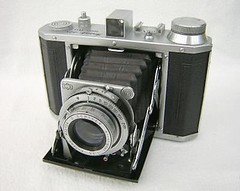 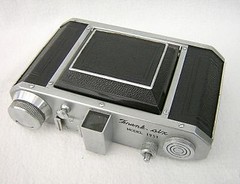
|
 
|
 
| |
| Frank Six Model 1951, C Seriter Anastigmat 75mm f/3.5 lens no.2724, early shutter plate, early T.K.S. engraving. Pictures courtesy of Robert Smith. (Image rights) | |
Evolution

|
| Frank in cursive style on the end plate. (Image rights) |
Very early examples of the dual-format Frank Six might still have the FRANK marking in capital letters at both ends of the camera.[4]

|
| T.K logo on the lens standard. (Image rights) |
The regular examples have the name Frank in cursive style on the endplates, instead of capital letters. The same T.K logo as engraved on the folding struts also appears on the corner of the lens standard opposite the self-timer.

|
| T.K.S. engraving in double struck style. (Image rights) |
The engraving on the speed rim changed at some time, around the switch from Model 1951 to Model 1952: it was altered from T.K.S. in double struck style to TKS in regular capital letters. The only Model 1952 example observed so far has the latter engraving style, and the words Tōsei.O.W 1952 embossed in the back leather (Tōsei.O.W is underlined and probably stands for Tōsei Optical Works).[10]
On the Model 1951 and Model 1952 examples, the shutter plate has a black stripe and is inscribed FRANK at the bottom. Around the switch to Model I, a pattern of black and white triangles appeared for some time, with a TOSEI marking at the bottom.[11] It was replaced again by a thicker black stripe with a black diamond at the top and the same TOSEI marking at the bottom.

|
| Early type of advance knob. (Image rights) |
Various detail changes occurred at some point, after the transition from Model 1951 to Model I. On the early cameras, the lens standard is chrome with a black logo, there is no logo on the folding bed and the advance knob has a flat metal top with an arrow indicating the winding direction. On the late cameras, the lens standard is black with a white logo, there is a T.K logo embossed in the leather of the folding bed and the advance knob has a round leather patch at the top and no arrow.
At least some Model I cameras have Tōsei.O.W 1953 embossed in the back leather, the same as the embossing of the Model 1952 example. (This embossing is perhaps present on all the Model I cameras but this is unconfirmed.) One example of the Model I with chrome lens standard is known with the year 1953 vertically stamped in the leather of the folding bed, where the examples with black lens standard have the T.K logo.[12]
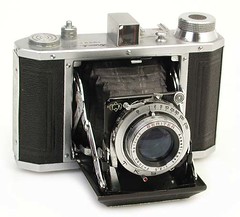 
|
| Frank Six Model I, Seriter Anastigmat 75mm f/3.5 lens no.12092, late shutter plate. Pictures courtesy of Scott at www.collectiblecameras.com. (Image rights) |
Commercial life
The camera was advertised as the Frank Six from November 1950, and was featured under that name in the February 1951 issue of Asahi Camera.[13] The first Frank Six model was presumably the Model 1951, followed by the Model 1952 in late 1951 or early 1952, then by the Model I. An advertisement dated May 1952[14] by Million Shōkai offered the Frank Six with Seriter lens for ¥10,000. The advertisement contains typos: the Frank Six is called "Flank Six" and the Semi Frank is called "Semi Flank". In the advertising picture, the advance knob has a flat metal top, the lens standard is chrome and the shutter plate is of the first type. An advertisement dated December 1952[15] shows the second type of shutter plate, with the triangle pattern.
The Sanon Six and Sanon Six II
The Sanon Six is a name variant of the Frank Six, distributed by Takasago Shōkai. The original Sanon Six was featured in the March 1953 issue of Ars Camera, with a Chibanon or Chibanone (チバノン) 80/3.5 lens and a TKS shutter.[16] The shutter is said to have a basic self-timer, perhaps consisting of a hole for a needle and thread: the shutter is released when the thread is pulled.[17] No picture of this model has been observed so far, and this version of the TKS shutter is otherwise unknown.
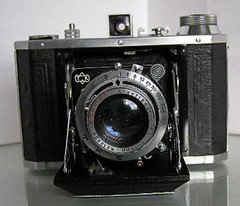 
|
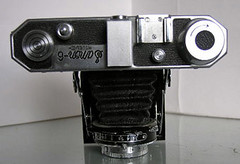 
|
| Sanon Six Model II, Seriter Anastigmat lens, TKS shutter. (Image rights) |
The Sanon Six II was offered for ¥8,500 in an advertisement dated June 1953.[18] The camera is identical to the late Frank Six Model I, with a black lens standard and a white T.K logo. It merely differs by the name Sanon–6 MODEL–II– engraved at the top. In the advertisement, the lens is perhaps called Chibar (チバー) and the shutter is a TKS with the late type of front plate, inscribed SANON at the bottom. The camera pictured above has a plain Seriter Anastigmat and a late TKS shutter, whose bottom marking is unclear.
The Sanon Six III and Muse Six
The Sanon Six III
The Sanon Six III has a top housing containing the eye-level viewfinder, slightly offset to the right as seen by the photographer. The accessory shoe is above the top housing, to the left of the viewfinder. The advance knob is quite similar to the knob of the Frank Six I, and there is a decorative film flange at the right end. The back is hinged to the right. The lens standard is black with a T.K logo. The camera's overall aspect is quite similar to the Frank Six IV, except for the absence of the brilliant finder.
The Sanon Six III was offered for ¥9,800 in an advertisement by Takasago Shōkai dated July 1953,[19] with a Tri-Lausar 8cm f/3.5 lens by Tomioka and a TKS shutter. Only one surviving example has been observed so far.[20]
The Muse Six
The Muse Six was advertised from August to October 1954 by the distributor Shinkō Shōji.[21] It is similar to the Sanon Six III, but has a Muse 80/3.5 lens and a TKS shutter only giving B, 10–200 speeds. It seems that the T.K logo has disappeared from the lens standard. The Muse Six was priced at ¥6,800,[22] perhaps to clear the stocks. No surviving example has been observed so far.
The Frank Six II and III
The Frank Six II
The Frank Six Model II has a chromed top housing quite similar to that of the Model IV, with an accessory shoe at the right end and an advance knob at the left end. In between, the housing contains two viewfinders: one eye-level viewfinder slightly offset to the right as seen by the photographer, and a waist-level viewfinder offset to the left. The eye-level finder has two vertical small green translucent marks acting as a mask to accommodate the smaller format; and the waist-level viewfinder has a black cross engraved over its screen - which is big enough to peer at it at some distance, unlike other similar WLF such as the one on the Welmy Six. On top of the middle part of the housing there is a small button to open the front of the camera.
The shutter release button is located at the rear part of the top housing, in between the accessory flash shoe and the eye-level finder. The advance knob has a small decorative leatherette cover and an arrow engraved on the chromed edge indicating the winding direction. The name Frank six is engraved in the top plate in cursive letters. The model name MODEL–II– is engraved just below, in red capital letters.
The rear door can be completely detached together with the bottom plate for film loading - which is done from right to left-, and (since the Model II is dual format) it has the two red windows with marks engraved for each format and independent sliding covers. The back door is locked by means of a rotating button with red O and L indications (for Open and Lock), and an arrow indicating the opening direction. There are plain metal plates at both ends of the body, acting as a light seal for the removable back. The leatherette for the front panel has T.K. logo embossed.
Only two surviving samples of Frank Six II are known to exist. The body of the first one has no serial number. The shutter is located on a black standard with a white T.K. logo on the upper left corner and the self-timer actuation lever on the upper right corner. The shutter is a TKS with the late type of front plate, B + 1–200 speeds and a self-timer. Lens is a multicoated Tri-Lausar 8cm f/3.5 lens by Tomioka with serial 2772. The back door is quite similar to the one of the Frank Six I[23]. The second sample is shown on the images below.
Lewis briefly mentions the Frank Six II as released in 1951[24].
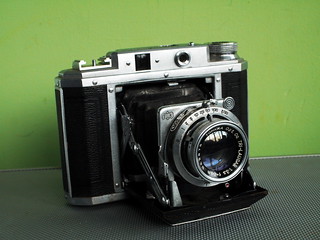 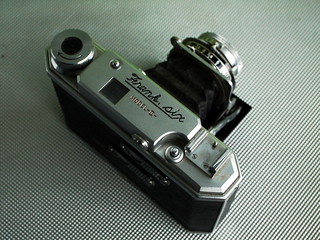
|
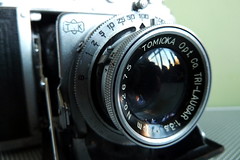 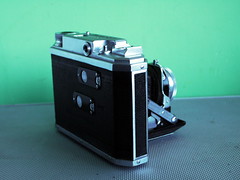 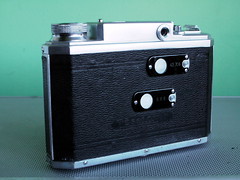
|
| Frank Six Model II . Images by Alastair Dandy. (Image rights) |
The Frank Six III
Almost nothing is known of the Frank Six III. It may be similar to the Model II with a different back door and maybe different lens. The Sanon Six III may be a similar camera.
Lewis briefly mentions the Frank Six III as released in 1952.[25] It is said that the Frank Six III was featured in a February 1953 column of Ars Camera.[26] An advertisement dated August 1953[27] lists the models I, II, III, IV and V, with no further detail.
The Frank Six IV and Liner Six
The Frank Six IV
The Frank Six IV has a top housing containing an eye level finder offset to the right and a waist level optical finder offset to the left. The accessory shoe is at the right end of the top plate, and the shutter release and folding bed release are located as on the Model I. The advance knob has a different shape, with a round leather patch at the top and an arrow indicating the winding direction. The back is hinged to the right and contains two red windows, similar to the red windows of the Model I.
The top housing is engraved Frank.six in cursive style and MODEL–IV– in red capital letters. The lens standard is black with a white T.K logo. The company name Tōsei.O.W is embossed in the leather of the back, under the red windows, and the T.K logo is embossed in the leather of the folding bed.
The shutter is a TKS (B, 1–200, self-timer), similar to the shutter of the Model I with the last type of shutter plate. The synch post consists of a single pin, an ASA bayonet or a PC socket.
The lens is a Tosei Anastigmat 80mm f/3.5 on most examples, sometimes with a red C engraving.[28] There are variations in the shape and colour of the lens bezel (silver or black). One example is known with a Tri-Lausar 8cm f/3.5 lens by Tomioka.[29]
The Frank Six IV was pictured in the August 1953 advertisement cited above,[30] where the lens was given as a Tosei 80/3.5 and the shutter as a TKS. The camera was offered for ¥9,800 with the same features in advertisements dated January and April 1954.[31] The model name is given as "Frank Six VI" in April 1954, perhaps by mistake.
The Liner Six
The Liner Six is a name variant of the Frank Six IV. The name Liner Six is engraved above the top housing, together with initials perhaps reading TSK, KSK or RSK.
One example has been observed with the usual TKS shutter and a Liner Anastigmat 80mm f/3.5 lens.[32]One example is known with a Tri-Lausar 8cm f/3.5 lens by Tomioka.[33] Another example is pictured in Sugiyama with a Rapidex shutter (T, B, 1–300) and a Lausar 7.5cm f/3.5 lens by Tomioka.[34] This lens and shutter equipment is certainly not original and probably comes from a wartime Semi Sport.
The Frank Six V
The Frank Six V is a rangefinder model, with a completely different top housing. The main body is similar to the Frank Six IV. The range- and viewfinder are combined in a single eyepiece, offset to the right as seen by the photographer. The rangefinder is certainly uncoupled but the position of the setting wheel is unknown. There is a sliding button at the front of the top housing, certainly moving a mask for 4.5×6cm pictures in and out of the finder frame. The shutter release and folding bed release are the same as on the model IV. The advance knob is the same too, except for the shape of the arrow. There is a film reminder at the right end of the top plate. The accessory shoe is in the middle, above the round rangefinder window. The lens standard is black with a white logo.
The name Frank–Six V.R (with an "R" surely for Rangefinder) is engraved above the viewfinder, together with the serial number and the company name TOSEI.KOKI CO, LTD. The T.K logo is also engraved in front of the accessory shoe.
Only one actual example has been observed so far. The shutter is certainly a TKS with a PC synch post, and the lens is a Tosei Anastigmat 80mm f/3.5. It has depth-of-field indications on a black background around the lens.
The Frank Six V was offered for ¥9,800 in the advertisements dated January and April 1954 cited above, with Tosei 80/3.5 lens and TKS shutter.[35]
Notes
- ↑ The synch pin is missing in the example pictured in this page, but its owner confirms that it was originally present.
- ↑ Dates, magazine issues: Kokusan kamera no rekishi, p.360.
- ↑ Advertisement reproduced in Kokusan kamera no rekishi, p.166.
- ↑ 4.0 4.1 Example pictured at this page, formerly at medfmt.8k.com (link is to an archived copy).
- ↑ Example pictured in this page, and example observed in an online auction.
- ↑ Role of this lever: Kokusan kamera no rekishi, p.352 (item 526, about the Sanon Six II).
- ↑ Sugiyama, items 1303–5, says that the Model I was made in 1950, before the Model 1951, but this is a mistake. This is repeated in McKeown, p.928, erroneously distinguishing the "Frank Six Model I (1950)" from the "Frank Six Model I (1953)".
- ↑ Example pictured in Sugiyama, item 1305, examples observed or reported in online auctions.
- ↑ 80mm focal length: example pictured in McKeown, p.928.
- ↑ Example directly observed by Rebollo_fr at the 2007 Bièvres fair.
- ↑ Sugiyama, item 1302 (Japanese text), and Kokusan kamera no rekishi, p.362 (items 779 and 783), say that the black and white triangle pattern is a feature of the early production examples. This is invalidated by the the analysis of the serial numbers of the Seriter lenses.
- ↑ Example pictured in McKeown, p.928.
- ↑ Kokusan kamera no rekishi, p.362.
- ↑ Advertisement published in Camera Fan, reproduced in Kokusan kamera no rekishi, p.174.
- ↑ Advertisement published in Asahi Camera, reproduced in Kokusan kamera no rekishi, p.174.
- ↑ Kokusan kamera no rekishi, p.352.
- ↑ Kokusan kamera no rekishi, p.352.
- ↑ Advertisement published in Photo Art, reproduced in Kokusan kamera no rekishi, p.138.
- ↑ Advertisement published in Photo Art, reproduced in Kokusan kamera no rekishi, p.139.
- ↑ Example observed in an online auction.
- ↑ Kokusan kamera no rekishi, p.370.
- ↑ Advertisement published in the August–September 1954 issue of Ars Camera, reproduced in Kokusan kamera no rekishi, p.200. The description of the Muse Six and Muse Flex IIA are swapped in this advertisement, and the name Muse Six is written ミューズシックズ, certainly by mistake.
- ↑ Furthermore, it is possible that exactly the same part was used, since the known unit has Tōsei.O.W 1953 embossed in the back leather
- ↑ Lewis, pp.75. On p.67, the same source contradictorily says that the Frank Six II was launched in 1949, but this is certainly a mistake.
- ↑ Lewis, pp.79.
- ↑ Kokusan kamera no rekishi, p.362.
- ↑ Advertisement published in Asahi Camera, reproduced in Kokusan kamera no rekishi, p.174.
- ↑ Example pictured in Sugiyama, item 1307, example pictured in McKeown, p.928, example pictured in this page (archived) at Japan Family Camera and examples observed in online auctions.
- ↑ Example pictured in Sugiyama, item 1306.
- ↑ Advertisement published in Asahi Camera, reproduced in Kokusan kamera no rekishi, p.174.
- ↑ January 1954: advertisement published in Asahi Camera, reproduced in Kokusan kamera no rekishi, p.137. April 1954: advertisement published in Camera Friend, reproduced in Kokusan kamera no rekishi, p.138.
- ↑ Example observed in an online auction.
- ↑ Seen in an on-line auction (Yahoo Japan)
- ↑ Sugiyama, item 1322.
- ↑ January 1954: advertisement published in Asahi Camera, reproduced in Kokusan kamera no rekishi, p.137. April 1954: advertisement published in Camera Friend, reproduced in Kokusan kamera no rekishi, p.138.
Bibliography
- Asahi Camera (アサヒカメラ) editorial staff. Shōwa 10–40nen kōkoku ni miru kokusan kamera no rekishi (昭和10–40年広告にみる国産カメラの歴史, Japanese camera history as seen in advertisements, 1935–1965). Tokyo: Asahi Shinbunsha, 1994. ISBN 4-02-330312-7. Items 525–7, 728, 779–82 and 953. (See also the advertisements for items 519 and 783.)
- Lewis, Gordon, ed. The History of the Japanese Camera. Rochester, N.Y.: George Eastman House, International Museum of Photography & Film, 1991. ISBN 0-935398-17-1 (paper), 0-935398-16-3 (hard). Pp.67–8, 75, 79 and 83 (brief mentions only).
- McKeown, James M. and Joan C. McKeown's Price Guide to Antique and Classic Cameras, 12th Edition, 2005-2006. USA, Centennial Photo Service, 2004. ISBN 0-931838-40-1 (hardcover). ISBN 0-931838-41-X (softcover). P.928.
- Sugiyama, Kōichi (杉山浩一); Naoi, Hiroaki (直井浩明); Bullock, John R. The Collector's Guide to Japanese Cameras. 国産カメラ図鑑 (Kokusan kamera zukan). Tokyo: Asahi Sonorama, 1985. ISBN 4-257-03187-5. Items 1303–7 and 1322.
Links
In English:
- Beauty Six (1950) at David Young's Furnfeather.ca
- Frank Six at Robert Monaghan's Medium Format Photography website (medfmt.8k.com: archived at the Internet archive 8 May 2006).
In Japanese:
- Frank Six (archived) at Photo Shop Saito